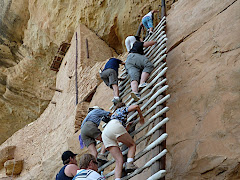entertainment
Bored? Looking for a new mode of transportation? Join thousands of Americans in this brand new discovery of railroad travel. No, I am not talking about switching from car to train for a daily commute. This is about train as entertainment. Everyday use of trains is in the same sorry state it has been since the demise of steam locomotive.
We’ve encountered this type of diversion twice so far: in Chama, New Mexico and in Durango, Colorado. Commercial application was abandoned in the 60s due to the usual reasons of cheap gasoline and better roads. In 90s is became tourist attraction. Clearly there are enough people willing to don dark clothes (to avoid staining by airborne soot) and spend a few hours in a densely packed open-air gondola cars chatting with strangers, which is advertised as particularly enjoyable. Upgrade to an adult-only parlor class available - obviously the organizers thought about anti-social types like us who are not overly fond of children. The railroads are engineering wonders. And they traverse one of the most picturesque parts of US. But if you buy a ticket be prepared to spend couple of hours traveling to nowhere: Osier, Colorado or Silverton, Colorado. Both are ghost towns.
I have nothing against spending one’s free time any which way one desires - whatever floats your gondola. I would go farther yet: let’s ditch mobiles and put nice rotary phones in to use for weekend amusement. Express bullet trains and smart phones with 100% coverage could be left to Europeans while Americans focus on what they do best - entertainment. And if it means sacrifice like living without chasing spotty reception so be it. More time to ride steam trains and to chat with strangers.
